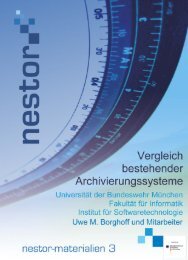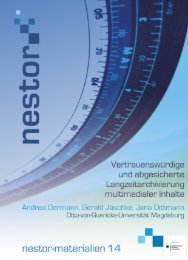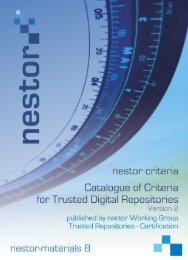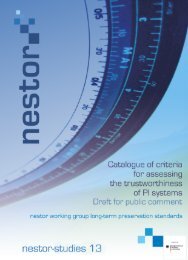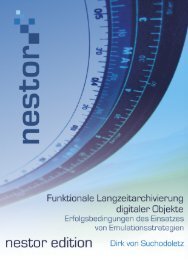Download (PDF, 9MB, Not barrier-free file.) - Nestor
Download (PDF, 9MB, Not barrier-free file.) - Nestor
Download (PDF, 9MB, Not barrier-free file.) - Nestor
- No tags were found...
Create successful ePaper yourself
Turn your PDF publications into a flip-book with our unique Google optimized e-Paper software.
Before any SIPs are accepted, the repository needs to negotiate and concludeagreements with the producers submitting their material for inclusion in the repository. Allthree criteria catalogs considered here contain criteria making the existence of a contractor agreement between producer and archive a requirement. Thus, according to therelevant nestor criterion, among others “the character and extent of the submission, thedigital repository's obligation to archive the submitted object, conditions of use, and – ifapplicable – cost” (2008, 3.1; my translation) have to be regulated in an agreement. Inaddition, the commentary to TRAC criterion A5.2 mentions the repository's “need to beable to work with and potentially modify digital objects to keep them accessible.” The DINIcatalog of criteria contains an extensive set of requirements and recommendationsconcerning legal (copyright) aspects of depositing material (especially if previouslypublished) in the repository. But while its treatment of copyright questions in connectionwith self-archiving or open access publishing via the repository is quite elaborate, thecatalog does not contain a criterion making it a requirement that the repository obtain allnecessary rights to carry out long-term preservation actions (regardless of whether thearchived document was previously published elsewhere or not). On the one hand thisreflects DINI's focus on all kinds of (open access) repositories, regardless of whether ornot they are concerned with questions of long-term preservation. It seems, however, thatthe inclusion of such a requirement would help repositories to prepare their collections forpotential long-term preservation measures at a later point so that the option to beginoffering long-term preservation services is not precluded from the outset merely becausethe repository has insufficient rights.The Archival Information Update function, which “provides a mechanism for updatingthe contents of the archive” (OAIS 2002, 4-11), is addressed by TRAC and the nestorcriteria catalog, both of which require the implementation of preservation strategies andpoint to migration and emulation as possibilities. As none of the repositories currently haslong-term preservation strategies implemented and will relegate related activities to along-term preservation service provider, this function will not be treated in the following.The aspect of Physical Access Control, an OAIS function “which providesmechanisms to restrict or allow physical access (doors, locks, guards) to elements of thearchive, as determined by archive policy” (OAIS 2002, 4-11) is covered by nestor and DINI(see nestor 2008, 6.2 and DINI 2007, 2.5.1), but not considered by TRAC. All of therepositories considered here have established sufficient <strong>barrier</strong>s limiting physical accessto their servers; hence this function, too, will not be discussed again in the following.A central task of the Administration functional entity is the establishing of standardsand policies, and it is here (as well as in the Preservation Planning entity treated below)that a considerable gap between “traditional” repository tasks and long-term preservationrelatedrequirements becomes apparent. According to OAIS, the standards to beestablished in the Administration functional entity “include format standards,59



